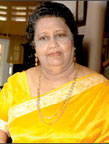|
strap International Women's Day
Development, economic growth and women
by Indeewara Thilakarathne and Ranga Chandrarathne
As the customary celebration of women's Day is around the corner, one
would wonder how far the women's social status, particularly in
Asia-Pacific region has been improved over the last 30 years. What are
the potential benefits that nation states could derive from improving
women's status in society?
 |
 |
 |
 |
 |
 |
| Benazir Bhutto |
Sonia Gandhi |
Farial Ashraff |
Sumithra Peries |
Anoja Weerasinghe |
Kaushalya Fernando |
However, the inseparable link the women's education with the
development and economic growth has been acknowledged and is directly
connected to achieving Millennium goals. Narrowing the gender disparity
in vital sectors such as education, employment has brought about
tangible results in terms of reducing child mortality, malnutrition and
substantially increasing economic growth.
There are some instances where family planning programmes conducted
by Government hospitals were scuttled by the misinformation campaign
launched by politicians who demonized the programmes as an attempt by
the professionals to decrease the population of a certain ethnic group.
In fact, the programmes were aimed at planned pregnancies allowing about
a three year's gap between births in order to make mothers and children
healthy.
In this particular district, teenage marriages are very common and
often poor families do not consult trained professionals assisting in
child birth. A notable case was death of mother and child at childbirth
though they virtually live on the threshold of the General hospital.
This birth was assisted by traditional midwife (Vinnabu Amma). People
still believe in traditional midwives rather than trained professionals.
Particularly in the District of Nuwara Eliya, maternal mortality rate is
very high largely due to the poor infrastructure facilities which make
healthcare facilities inaccessible to people living in rural hamlets.
Therefore, concerted effort and inter-ministerial approach should be
adapted to stamp out mythical beliefs with regard to child birth and to
prevent teenage pregnancies.
According to a discussion paper by the United Nations Development
Programme (UNDP), the link between the gender equality and economic
growth has been established based on empirical data. It has also been
observed that apart from denying human rights, gender inequality results
in hampering economic growth, lowering productivity and social
development. The vital areas that need a radical change and policy
initiatives which would have a profound impact on narrowing gender
inequality are education, health, employment and political
participation.
Large sums of money have been allocated by the Government not only
through the Ministry of Women's Affairs but also through other
Ministries and statutory boards and through different programmes to
empower women who constitute over 55 per cent of the population. UN's
contribution in this regard is positive," says Indrani Sugathadasa,
Secretary of the Ministry of Women's Affairs. "As the gender equality is
one of critical social issues, UN has allocated unprecedented amount of
founds for this year towards empowering women which will be channeled
through diverse programmes," said UNDP head Neil Bhune.
Duty versus personal freedom
Although women have progressed in many areas, a very little has
changed in terms of attitude towards women. Harassment of women in
public places is still widespread. For instance, grouping in public
transport has become a phenomenon and this has recently extended to
mushrooming three-wheelers. An unmarried medical officer was approached
by a three-wheeler driver who thought that she would be an easy prey.
Upper middle class women are perceived freed from the mind-forged
manacles of customs and tradition imposed restrictions. However, she has
gone into a society, which still believes, on a set-role for women.
Sri Lankan mothers-in-law are still demanding dowry from their
would-be-daughters-in-law. This has placed undue importance on the
material and monetary gains virtually undermine the fundamentals of
marriage; matching personality, the understanding.
A dental therapist mother-in-law, who offers flowering tributes,
every morning and evening to Buddha, demanded an exuberant sum of one
million rupees as dowry and the father of the daughter-in-law to be had
to retire and contribute the entire provident fund to settle the
pre-marriage dispute.The customary wedding cake and necklace which
should have been offered by the engineer bridegroom had also to be
financed by the family of the would-be-bride. The most hilarious part
was that the 'home coming 'was also held at a hotel spending more than
Rs. 250000 from the dowry. Mother -in-law demanded a wooden almirah
despite the one million cash, a house and jewellery.
However, their mother-in-law started to harass her daughter. This was
an attempt of the mother-in-law selling the degree certificate of her
son to gain quick-money to lead a life of luxury at the expense of the
daughter-in-law's goodwill.
Although we could not reform fossilizing mothers-in-law, we could, at
least, educate the next generation to respect women's dignity.This
behaviour on the part of the three-wheeler driver was born out of
prototype beliefs entertained by the lower strata of the society that
each and every single-woman can be approached and would be easy preys
for them. In another instance, a mother-in-law demanded of her son the
time, manner and the days that her daughter-in-law should have sex
following the abortion of the first child.The tragedy of all these
instances is that the mothers-in-law and members of the families were
professionals. This is a serious lapse in education which has only
imparted knowledge maintaining the age-old obsolete ideas and
misconceptions in the name of culture.
Although women all over the world converge in unison to dramatise the
shameful condition of their being separated, isolated, deprived of their
rights and more or less the denial of their lives in the name of
culture; their rights are still written as an unrealized promissory
note.
Continuous agitation coupled with a process of education should be
launched to stamp out social prejudices and improve the condition of
women in general and working women in particular.
Women should ponder on alternative ways and means in changing social
attitudes with the intention of winning over personal freedom and rights
overcoming some of the socially-imposed duties rather than merely
protesting annually when the world mark the International Women's Day.
The nexus between gender equality and economy Education has been a
tool of empowerment of vulnerable sections of the population such as
women, poor. Education not only raises the livelihood opportunities for
women but also contribute to the long term economic growth and building
up an informed society.
Although governments in the Asia pacific region are committed to
narrow the gender disparity in education, the percentage of women's
participation, especially in secondary schooling remain uneven. The
collected data over past 30 years in the Asia Pacific region indicates
that higher economic growth has been significantly attributed to the
reduction of gender disparities in education.
The data further suggest that education of girl, especially at high
levels, is a necessary component in achieving constant economic and
social progress. Quality education will raise qualifications on the part
of women enabling them to gain better employment. One of positive
outcomes of better employment is the raise of income which in turn,
enables higher income earners better access to information. Further
those who earn higher income often become part and parcel of informed
population. Such an informed population demands for accountability of
public officials leading to good governance and strong civil society.
The effective education of women yields important outcomes including its
contribution to productivity and total output. However, benefits of
gender equality in education will not confine to the areas of economic
growth.
They will extend to the areas of child mortality, fertility,
nutrition and even the education of the next generation. Lawrence
Summers, a researcher concluded that the education of girls may be the
investment with the highest returns available in developing countries.
His work sums up number of well-established findings such as higher
death rates symptomatic of the more general pattern of female
deprivation in the developing world. He further pointed out that major
initiatives to increase female education can transform society over
time. Summers calculated if more girls had attended school in the
previous generation, millions of infants' deaths could have been averted
each year and millions of families could have been happier and
healthier.
Status of female education in Asia-pacific region
Although the education of female has been improved in the region,
women and girls education substantially varies across the region.
The gender gap in the education remains the most pressing issue
hampering economic and social progress. According to a recently issued
UN report, number of girls in the age of 7-12 not attending schools is
62 million. Although in East Asia and in larger part of South Asia,
female literacy rate is either equal or surpassing that of males, in
South Asia female literacy rate remains low. For instance, in Pakistan
there are only 64 literate women for every 100 literate men. In
Afghanistan, 86 per cent of Afghan women are illiterate compared to 57
per cent in male.The gender gap in secondary education is the highest in
South Asia. It has been estimated that only 36 per cent of girls are
attending secondary school compared to 44 per cent boys in the region.
However, in Sri Lanka, female participation in secondary school is
little higher than the males (about 85%). The data indicated that
countries with higher per capita GDP such as Japan, Australia and New
Zealand have been able to reduce the gender gap in secondary education.
However, few Asian countries, despite their lower per capita GDP, have
been able to reduce gender gap in secondary education. For instance,
Bangladesh, Kiribati, Mongolia and Sri Lanka have able to reduce gender
gap although the per capita GDP is below 1000 dollars a year.
Gender equality in education will also help reduce adolescent
fertility and child mortality rates. During 1990-2000 decade, progress
of reducing births among very young women was very slow in Asia-Pacific
region. (Live birth in one year per 1000 women aged 15-19 years).
In addition to increasing risk of pregnancy related deaths,
adolescent fertility adversely affects on young women's opportunities
for further education and engaged in a better quality of income earning
activities. |
